Brendan Pang on dumplings, MasterChef, his new cookbook and how his grandmère inspired it all
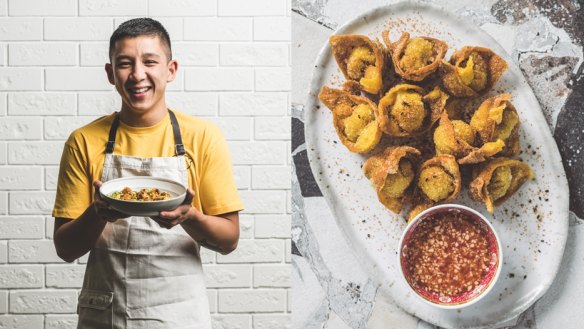
Brendan Pang owes a lot to his grandmère Josephine. She taught him to catch and fillet fish, she taught him to cook the food of his Mauritian Chinese heritage, and, perhaps most importantly, she taught him how to make wontons and noodles from scratch – two dishes that have become his legacy from this season of MasterChef: Back to Win.
But watching 27-year-old Pang proudly show off his culture and cuisine on the series, cook his own take on traditional dumplings (which have not only turned into a successful business for him but now also his own cookboo) all while supporting his co-stars with sincerity and kindness, it's fair to say that Pang deserves some of the credit, too.
In the two years since his original MasterChef season aired in 2018, the Perth-born chef knew food was a career to commit to – he launched his own food van, Bumplings, in an aluminium Airstream in Fremantle food and drink space The Sunshine Harvester Works to great success. He finished eighth in this year's Back to Win season, and his fans will soon be able to recreate their own versions of the dumplings he cooked on the show as he launches his very first cookbook, This is a Book About Dumplings, in August.
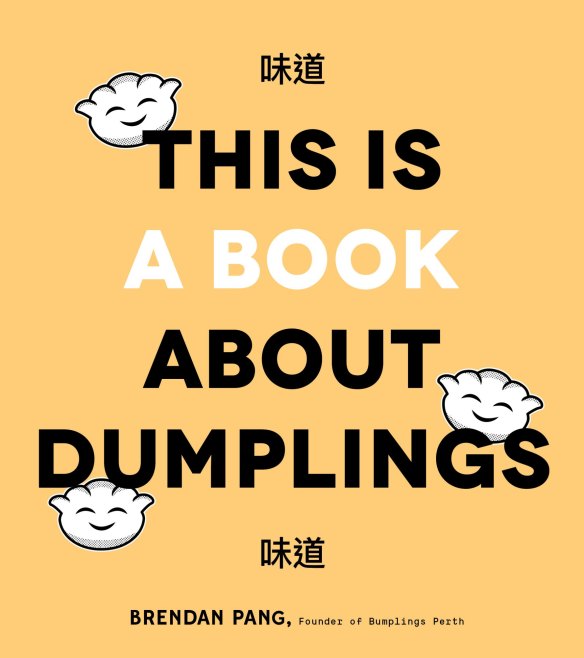
"The book for me was helping break down some fears for people out there who are afraid of making dumplings for the first time," Pang says. "There is a common misconception that they take years to perfect but when you break it down – all you need is flour, water and a tasty filling, which can be made from almost anything."
The book features more than 30 recipes for Chinese-style dumplings, including Pang's favourite, the Chinese spicy beef potstickers, which he says are "everything you want in a dumpling. Steamed on top, crispy on the bottom, juicy on the inside and a little kick from the spice". Pang also includes recipes for dipping sauces, oils, wrappers, noodles and those wontons his grandmère taught him all those years ago. "I grew up eating these and they've always had a special place in my heart."
Pang says his Mauritian heritage has been a major help in his cooking career. "Mauritius is a melting pot of cuisines (Indian, Chinese, French and Creole). It's been handy growing up eating and cooking with different flavours – some which don't naturally complement each other."
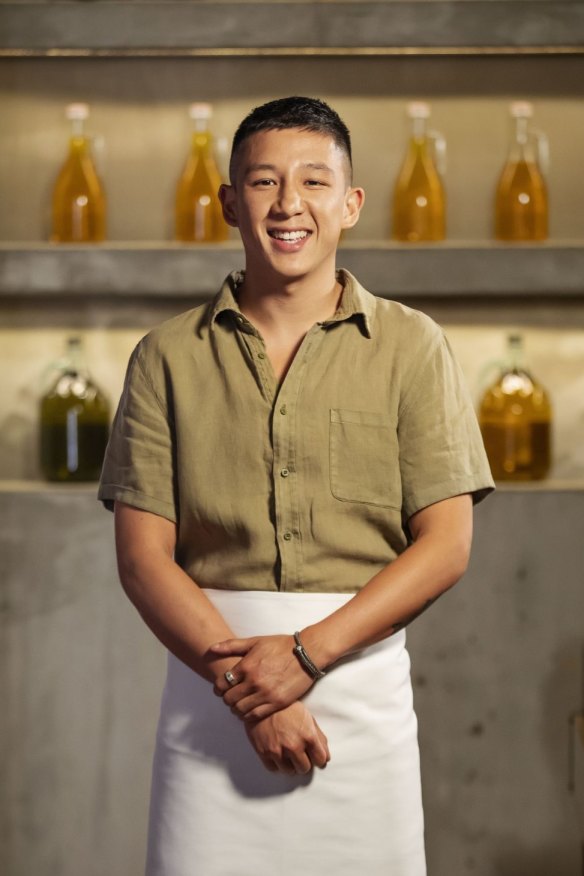
He plated up his culture proudly on the show, a season that has been praised for its diversity in its judges, contestants and pantry ingredients. "Having the opportunity to share in such a diverse season made it all the more worthwhile," he says. "I am proud of who I am and I am humbled to have been able to show it on the plate and have it celebrated by the rest of Australia."
Brendan Pang's five tips for making the perfect dumpling
- If you've never made dumplings before, start with something simple such as wontons.
- Incorporate an egg into your filling to help create a light and silky texture.
- To make sure your filling is juicy and not dry after you cook it, use a fattier protein. Alternatively, you can beat a little liquid into the filling, such as stock.
- Choose the right dumpling wrapper for your intended cooking method. For example, wonton wrappers work best when boiling and deep-frying and gow gee wrappers are best when steaming or pan-frying.
- Don't overfill your dumplings. There is a fine line between overfilling and underfilling. The best way to overcome this is to make as many as you can so you get a good feel for filling-to-wrapper ratio.
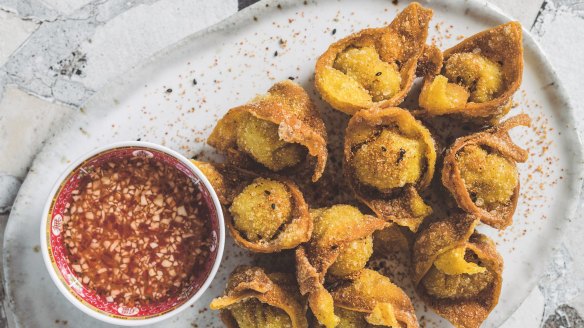
Grandmère's fried shrimp wontons
While I was growing up, Grandmère made her fried shrimp wontons a regular at any family gathering. What really makes this recipe a winner is how easy these are to prepare, so it is probably a good one to start with. The wrapper and the fold itself don't need to look perfect – they're just going to get deep-fried anyway!
Makes: 24
INGREDIENTS
Filling
- 300g raw large prawns, peeled, deveined and diced
- 2 tbsp tamari
- 1 tbsp finely chopped fresh coriander leaves
- 1 tsp finely grated fresh ginger
- 1 spring onion, finely sliced
- 1 tsp sesame oil
- 1 tsp Shaoxing rice wine
Chilli and garlic dipping sauce
- ¼ cup (60 ml) white vinegar
- Pinch of salt
- ½ tsp superfine sugar
- 1-2 red bird's eye chillis, finely chopped
- 1 medium garlic clove, finely grated
- 24 wonton wrappers
- Vegetable oil, for frying
METHOD
- Make the dipping sauce: In a small bowl, stir together all the sauce ingredients until the sugar has dissolved and the mixture is well combined. Cover and refrigerate until needed.
- Make the filling: In a medium bowl, combine all the filling ingredients and mix vigorously in one direction until the mixture binds. Cover and let rest in the fridge for 30 minutes.
- Working with 1 wonton wrapper at a time, place a teaspoon of filling in the centre. Brush half of the edges of the square with water. Fold the wet edges over in half to make a rectangular shape and enclose the filling. Brush one of the corners with water and fold inward to overlap with the other corner. Press to seal. Cover loosely with a clean, damp tea towel and repeat the process to form the remaining dumplings.
- Cook the wontons: Fill a wok about two-thirds full with vegetable oil. Heat to 180C and test by dipping a wooden chopstick into the oil: The chopstick will sizzle when the oil is ready. Working in batches, gently lower the wontons into the oil and cook until golden brown, 3 to 5 minutes. Drain on a plate lined with paper towels and serve immediately with the chilli and garlic dipping sauce.
NOTE: Make them an hour or so before serving – keep them hot in the oven on low heat.
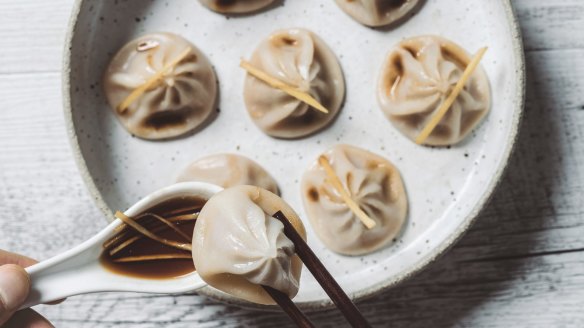
Shanghai soup dumplings
There is no denying Shanghai soup dumplings are difficult to prepare, but start out with ones that are a little bigger than usual, then scale down as you gain confidence and skill. Avoid getting any filling on the edges and be sure to pinch firmly as you pleat, to create a tight seal.
Makes: 35
INGREDIENTS
Ginger Vinegar Sauce
- 3 tbsp Chinese black vinegar
- 2 tsp tamari
- 2 tbsp julienned fresh ginger
Pork Soup Jelly
- 120g pork rind
- 6 tbsp sliced fresh ginger
- 3 spring onions, white part only
- 4 tsp Shaoxing rice wine
- 1½ cups (355ml) water
Filling
- 2½ tbsp finely grated fresh ginger
- 1 spring onion, finely minced
- ½ cup (125ml) just-boiled water
- 450g fatty ground pork
- 4 tsp oyster sauce
- 2 tbsp + 2 tsp light soy sauce
- 2 tsp salt
- 4 tsp sesame oil
- 1 tsp castor sugar
- 35 gow gee dumpling wrappers
METHOD
- Make the ginger vinegar sauce: In a small bowl, stir together all the sauce ingredients. Cover and refrigerate until needed.
- Make the pork soup jelly: Fill a small saucepan with water and bring to a boil over high heat. Add the pork rind and cook for about 5 minutes, or until it becomes slightly translucent. Remove the pork rind and rinse the pan with water to remove any impurities. Cut the pork into small strips and place in a pressure cooker along with the ginger, spring onions, Shaoxing rice wine and water. Cook on high pressure for 40 minutes. Let the soup cool down slightly, then use an immersion blender to process until smooth. Strain into an airtight container and refrigerate overnight.
- Make the filling: Soak the ginger and spring onion in the just-boiled water for 15 minutes. Place the pork in a large bowl and mix in one direction while slowly pouring in the ginger mixture until well combined. Mix in the remaining filling ingredients, cover and let rest in the fridge for 15 minutes. Remove the pork jelly from the fridge and mince with a knife. Mix into the filling.
- Working with 1 dumpling wrapper at a time, place 1 tablespoon of filling in the centre. Place the wrapper flat onto a working surface and, using both sets of your index fingers and thumbs, pinch the edge firmly to fold a pleat. Continue this until you have formed pleats along the entire edge of the wrapper. Pinch and twist the dough at the end to ensure it is completely enclosed and sealed.
- Line a bamboo steamer by placing your steamer basket on a sheet of baking paper. Trace around the basket with a pencil and cut the paper with scissors. Place the cutout in the basket and carefully poke holes with a knife to allow for steam to come through. Place your basket in a wok. Pour enough water into the wok for the water line to be 2.5cm below the bottom of the steamer. Place the Shanghai soup dumplings 2.5cm apart in the steamer basket to allow for them to expand. Place the wok over high heat. Once the water is boiling, steam in batches for 6 to 8 minutes, or until the dumpling skin is transparent and the filling is firm and cooked through. Serve immediately with the ginger vinegar sauce for dipping.
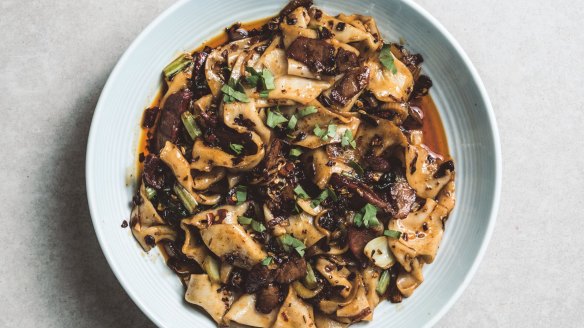
Biang biang noodles with spicy cumin lamb
Cumin is the major player in these noodles from central-northern China. Toast your spices first in a dry wok to really amp up the flavour and toastiness as well as bring out the signature nuttiness of the cumin. Making the noodles themselves is super easy! No intricate wrapping or preparation required – just roll out your dough and cut the noodles by hand, nice and thick – it works better if they're irregular and uneven!
INGREDIENTS
Noodles
- 3 cups minus 1 scant tbsp (365g) all-purpose flour, plus more for dusting
- Pinch of salt
- ⅔ cup minus 1 tsp (155ml) water, plus more if needed
- Vegetable oil, for coating
- Dash of sesame oil
Lamb mixture
- 400g fatty lamb shoulder, sliced
- ¼ cup (60ml) vegetable oil, divided
- 3 tbsp Shaoxing rice wine, divided
- 1 tsp cornstarch
- 1 tbsp cumin seeds, toasted
- 2 tsp coriander seeds, toasted
- Pinch of ground white pepper
- 2½ tbsp finely grated fresh ginger
- 2 spring onions, white part only, chopped
- 1 small head garlic, minced
- 1 red chilli pepper, sliced
- 3 tbsp roasted Sichuan chilli oil, plus extra to serve
- 1 tsp castor sugar
- 1 tsp Chinese black vinegar
- 1 tbsp soy sauce
- Pinch of salt
- 1 red onion, thinly sliced
- 3 heads bok choy, cut into chunks
- 1 bunch coriander, separated into leaves and finely sliced stalks, plus extra to garnish
- 1 tbsp sesame seeds, toasted
METHOD
- Make the noodles: In the bowl of a stand mixer fitted with the dough hook attachment, combine the flour and salt. Starting on low speed, slowly incorporate the water. If the dough is a little dry, add another tablespoon of water at a time. Increase the speed to medium and let knead for 10 to 15 minutes, or until smooth and elastic. Cover with plastic wrap and let rest for 1 hour.
- Line a baking sheet with baking paper and set aside. Brush a clean work surface with vegetable oil and press the dough into a 1.3-cm-thick rectangle. Cut into 10 to 12 equal strips, laying them flat on the oiled surface. Pick up 1 noodle by both ends and lift it while slapping it repeatedly onto the work surface as you stretch it to a ribbon that is about 20cm long. Place your noodle on the prepared baking sheet and repeat the process. Cover with plastic wrap to prevent drying out and set aside until needed.
- Prepare the lamb: In a medium bowl, combine the lamb, 1 tablespoon of the vegetable oil, 1 tablespoon of the Shaoxing rice wine and the cornstarch. Toss well and set aside to marinate for at least 30 minutes.
- In a mortar and pestle, grind the cumin seeds, coriander seeds and ground white pepper together and set aside until needed.
- Cook the noodles: Bring a large pot of salted water to a boil. Cook the noodles for 2 to 3 minutes, or until they rise to the surface. Drain and transfer to a bowl. Toss with a dash of sesame oil to stop them from sticking.
- Heat a large wok over medium heat and add the remaining 3 tablespoons of vegetable oil followed by the ginger and spring onions. Cook, stirring, for 1 minute before adding the garlic and chilli. Cook for an additional 30 seconds. Increase the heat to high and add the lamb. Stirfry until just browned, then add the remaining 2 tablespoons of Shaoxing rice wine, the spice mixture, the chilli oil, sugar, black vinegar, soy sauce, salt, red onion and bok choy. Cook until the bok choy is just cooked but still crunchy. Add the cooked noodles, coriander and toasted sesame seeds. Toss gently before serving.
- Serve with chopped coriander and roasted Sichuan chilli oil, as desired.
Reprinted with permission from This is a Book About Dumplings by Brendan Pang, Page Street Publishing Co. 2020. Photo credit: Thomas Davidson